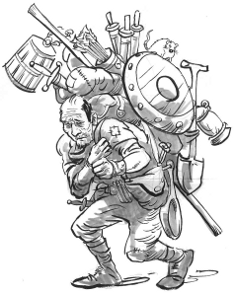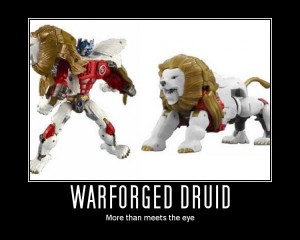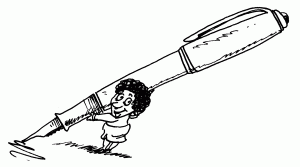 After bashing NPCs on a previous post I think this time around I’ll show them some love. I won’t claim the advice I’m going to give is wholly original. It’s the collected wisdom of many GMs that came before me, sprinkled with my own humble experience. If you are an experience GM some of this advice may seem basic, but it’s always good to get a refresher. And besides, there are always new players discovering the game and we hope some of them will stick around and become GMs, so I hope this is of use at least to them!
After bashing NPCs on a previous post I think this time around I’ll show them some love. I won’t claim the advice I’m going to give is wholly original. It’s the collected wisdom of many GMs that came before me, sprinkled with my own humble experience. If you are an experience GM some of this advice may seem basic, but it’s always good to get a refresher. And besides, there are always new players discovering the game and we hope some of them will stick around and become GMs, so I hope this is of use at least to them!
Wikipedia has a nice succinct definition of what NPCs are, so here it is! As I’ve said before, NPCs are what makes the world around your NPCs come alive. They populate the setting, sell goods, give hints, become romantic interests, captives and meat shields (all on one session!) and are the GMs best friend. If you make them believable and unique, your players will never forget them. There are numerous GM advice books, columns and blog posts that talk about NPCs so make sure you search them out. This is just what works for me.
1. Don’t overdo it! – That’s the first thing you need to internalize. Not every NPC will be memorable or recurring. There will be plenty or bartenders, innkeepers, space station customs officer and police detectives the players will never meet again. You don’t need to flesh out each and every one of them. Stating up every last NPC the PCs meet is a sure way to GM burnout. Know what role they will play and give each one something unique, an accent, a facial tick, describe some detail (Are they slovenly? Missing teeth?) unless they are simply a throw away name (“You go into Benny’s shop and get the supplies, let’s go…), in which case a name will suffice.
Even important NPCs and some minor antagonists don’t need to have full write ups. Most games have sample NPCS of varying levels or creature stats, it’s a simple matter of using those stats and simply describing their effect differently. Need the bodyguard of a noble to roll a save? Looks for the stats of the city guard captain and use that value. The PCs are fighting some militia members in a hostile planet, use the statistics for the alien enemies, and just describe them as the militia members. The wonders of re-skinning! Only work on the most crucial NPCs, the main antagonists, and you will save a lot of time.
2. Make them memorable… – What? I tell you to not overdo it names and then I tell you this! What sort of advice is this? Well let’s build off the previous piece of advice. Making an NPC memorable depends on its role, if he is merely a merchant in the post apocalyptic wastes that the PCs trade with, a quick description of his clothes, the sunburned skin, and the raspy voice are enough to paint sketch the PCs can use to construct their vision of the NPC. Accents and mannerisms are another way to make NPCs come alive, but that depends if you as a GM feel comfortable doing voices and a little improvisation.
 You don’t have to be a thespian to pull off a weird accent or act out a limp, you can even use exaggerated movie style accents, just avoid the clichés (the Scottish dwarf or starship engineer come to mind)! GMing styles differ, and some GMs don’t feel comfortable acting out or making funny voices, and that’s fine. Then describe, describe, describe! Don’t overdo it, remember point one. Describe in proportion to the NPCs importance.
You don’t have to be a thespian to pull off a weird accent or act out a limp, you can even use exaggerated movie style accents, just avoid the clichés (the Scottish dwarf or starship engineer come to mind)! GMing styles differ, and some GMs don’t feel comfortable acting out or making funny voices, and that’s fine. Then describe, describe, describe! Don’t overdo it, remember point one. Describe in proportion to the NPCs importance.
Names are another way to make NPCs unique, name the NPCs and drop names of people in conversation, much like real people do, even if the PCs don’t necessarily know whom the NPCs is talking about. This makes the world seem real, but be mindful of players who think every name that comes up in conversation might be a clue. You may simply tell them outright if you see them hunting down a tangent, or show them that Old Lady Herrigan is just that, an old lady tending her chickens (which I think is a more satisfactory way, but may become a distraction you want to avoid if your gaming time is limited).
On the other hand listen to your PCs and their suspicion that Old Lady Herrigan is a cultist, this may inspire you and you may run with it, if you are comfortable with improvisation and making things up on the fly as the adventure progresses. This has the benefit of making the players feel as if they are right, just avoid doing it all the time or it may become implausible.
On the matter of names a slight detour, I’ve written about names before and here are two additional ideas, try to find list of names of cultures, real or imaginary, and assign them to different cultures or species in your campaign, then when you name an NPC pick from the appropriate list. This has the benefit of internal consistency and you avoid having to come up with names off the top of your head. Also scratch off names you have already used on the list, there is nothing more frustrating than too many NPCs with the same name (“Are we talking about John the blacksmith, John the city guard or John the king’s son?”).
3. Show, don’t tell – That may seem like odd advice for what is mostly a narrative game, but the adage of the picture and the thousand words applies here. You may not always be able to get a picture of the dungeon room, the fore brooding castle or the exact the ship you want but you can use your descriptions for all those. For NPCs an image usually cements the look in a player’s mind. A picture has the added advantage that without spending too much time on descriptions every player knows what the NPC looks like. Pictures and art are easy to find in online searches and art sites and are an excellent short hand when you feel less than able to describe NPCs.
 As part of your prep you may collect images that inspire you and use them for NPCs. Also if you feel you can’t come up with good enough descriptions the art or pictures may provide you with details or inspiration.
As part of your prep you may collect images that inspire you and use them for NPCs. Also if you feel you can’t come up with good enough descriptions the art or pictures may provide you with details or inspiration.
If you do a lot of preparation for your game you can cover most important NPCs ahead of time and have a couple of stand ins for unexpected situations. You can either print them out or if you game with a computer you can keep a folder of NPC images and pull them up as the need arises. Organize folders by themes, city guards, barkeeps, aliens, elves and you can always have an image ready.
I don’t know about your GM style but I tend to run a hybrid of planned adventures with some improvisation. I write an outline for the campaign and specific arcs (a series of adventures) and then some bullet points for individual sessions, which contain plot elements, NPCs, etc, and then fill in the details as we game. I then revise my arc notes after each session. This means I leave a lot of leeway and wiggle room when I GM, so oftentimes unexpected NPCs crop up. That makes it hard to have images handy, even when I’m prepared, and I end up describing the NPC and then having to scour for an image to match the description. This takes me to my next piece of advice…
 4. Take notes – Whether it’s because you want to make sure you remember how you described the NPC so you can look for an image later on some art book or online, or simply so you remember that Terry the forger was left handed, note taking is a vital skill for a GM, not just when it comes to NPCs. Note taking is one of those things they try to teach you in school and some people are good at it, some not, and there are different ways to go about it that work for some and not for others. I’ve integrated the use of my laptop to my GMing to the point I’d feel lost without it anymore. I take detailed notes in a sort of shorthand that I can then flesh out or complete when I review the notes after the adventure.
4. Take notes – Whether it’s because you want to make sure you remember how you described the NPC so you can look for an image later on some art book or online, or simply so you remember that Terry the forger was left handed, note taking is a vital skill for a GM, not just when it comes to NPCs. Note taking is one of those things they try to teach you in school and some people are good at it, some not, and there are different ways to go about it that work for some and not for others. I’ve integrated the use of my laptop to my GMing to the point I’d feel lost without it anymore. I take detailed notes in a sort of shorthand that I can then flesh out or complete when I review the notes after the adventure.
Whether you do it on a computer or on a piece of paper, jot down details about NPCs. This means that you can be consistent, if the PCs ate at the Rampaging Boar the last time they were in town and the barkeep was Rudolph, when they come back and visit the same spot the place won’t be the Savage Boar, with Hubert as the barkeep, unless there is story behind the name change and the new barkeep.
Take notes on even the most minor NPCs, those ones I told you not to fret about before. Why? You never know what NPCs the players will remember. The solitary merchant in the post apocalyptic waste may unexpectedly become a recurring NPC. Remembering who the city guard was last time around and running into him again makes the world seem real and helps with the suspension of disbelief.
And last but not least…
 5. Never become too attached! – This builds upon my previous post on NPCs but it’s worth repeating. As a GM the NPCs are your best tool to make the world come alive, to speak to the PCs without doing so directly, to hint, prod and motivate, but they are not your characters. The protagonists of the game are the PCs. This does not mean they should always triumph, or that things should be a cake walk. Challenge them, let them taste defeat, or at least setbacks, once in a while (just don’t be heavy handed), victory will taste that much sweeter!
5. Never become too attached! – This builds upon my previous post on NPCs but it’s worth repeating. As a GM the NPCs are your best tool to make the world come alive, to speak to the PCs without doing so directly, to hint, prod and motivate, but they are not your characters. The protagonists of the game are the PCs. This does not mean they should always triumph, or that things should be a cake walk. Challenge them, let them taste defeat, or at least setbacks, once in a while (just don’t be heavy handed), victory will taste that much sweeter!
NPCs are window dressing, plot elements, some very important, pivotal in fact, but they are not the players. Always keep that in mind. And if you feel too invested on an NPC, kill it off, if the PCs cared for him or her they will react, if not, well it was just you being too attached. Good riddance!
If you do your work NPCs will become important to the players, they will establish relationships, care for their well being and become ideal targets for your nefarious plots. It is so much more satisfying to rescue Theresa the maiden from the goblin war band that captured her, than some random and nameless princess from a dragon.
I hope this advice can be of some use to you. What do you do with NPCs in your games? How do you make them come alive? I’d sure like to know…
PS – Big thanks to Alana, a friend from Puerto Rico Role Players who shared the image of the Warforged Druid image in this post. I have no idea where she found it but I just HAD to use it.
1 Response
[…] Making NPCs come alive! from Stargazer’s World (stargazersworld.com) […]